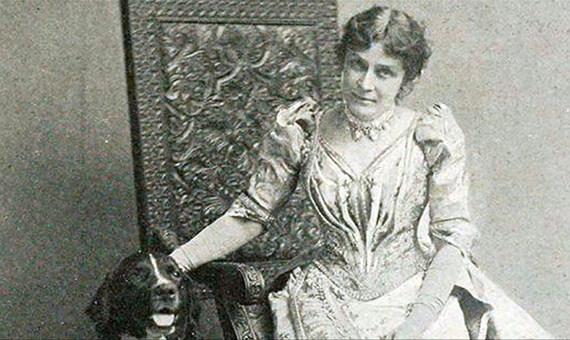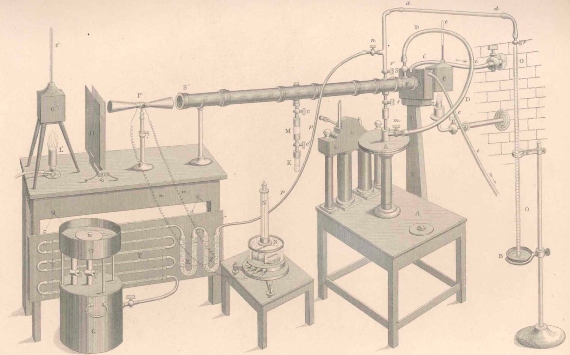Until a decade ago, the science of climate change had as its founding father John Tyndall, the Irish physicist who in 1859 demonstrated what we know today as the greenhouse effect, global warming due to the atmosphere. But as is so often the case, research not only helps us to move forward, but also to stop, look back and discover what we have forgotten along the way. And so it was that in 2010, the curiosity of a retired geologist discovered that we had somehow left behind Eunice Newton Foote (17 July 1819 – 30 September 1888), a pioneer of women’s rights who for a century and a half has been forgotten as the scientist who beat Tyndall by three years; the greenhouse effect had a founding mother before it had a founding father.
In the mid-19th century, the women’s rights movement was gaining momentum. In July 1848, the first convention was held in Seneca Falls, New York State, led by pioneering activist Elizabeth Cady Stanton and local Quaker women. The result of that meeting was the Declaration of Sentiments, a manifesto for women’s rights—including suffrage—which was signed by 68 “ladies” and 32 “gentlemen”. Among the former were Stanton herself, her sister Harriet and other activists such as the Quaker sisters Lucretia Coffin Mott and Martha Coffin Wright.

Among the 68 women signatories was also the name of Eunice Newton Foote, a young woman born in Goshen, Connecticut, raised in Bloomfield, New York, who was married to judge and mathematician Elisha Foote, had two daughters named Mary and Augusta, and was a friend and neighbour of Elizabeth Cady Stanton in Seneca Falls. Like the other 99 signatories, Eunice Foote deserves to be remembered for having been instrumental in advancing a cause so necessary for social progress at a time when the struggle for women’s equality was seen as an extravagance, a danger, or merely a waste of time.
A descendant of Newton and pioneer of environmental science
But in other respects, Eunice Foote would remain a footnote in the history books. That notation would say that she was also a science-loving woman; her surname is no coincidence, as her father was apparently a distant relative of Sir Isaac Newton, and in fact bore the same first name as him. Among Eunice’s influences was Amos Eaton, who is credited with introducing higher education in science in the USA. Trained in science but without a university degree—which at the time was an avenue generally closed to women—Eunice spent part of her time experimenting, publishing the first two physics studies by a woman in the US, and dreaming up inventions such as a filling for the soles of shoes and boots to prevent squeaking when walking.
And that was all there was until 2010. In that year, retired geologist Raymond Sorenson, a keen collector of old technical books, which he stored in his basement in Oklahoma, was reading a copy of the 1857 edition of the Annual Scientific Discovery, edited by engineer David A. Wells. There he found Eunice Newton Foote’s first paper, published the previous year in The American Journal of Science and Arts and curiously preceded by one by her own husband. Both were on the study of heat from the Sun’s rays, and both had been read on 23 August 1856 before the American Association for the Advancement of Science (AAAS, publisher of Science magazine).

In her brief study, entitled Circumstances affecting the Heat of the Sun’s Rays, the amateur scientist described an experiment in which she exposed glass cylinders equipped with thermometers to the Sun and attached to a pump to draw air from one and compress it in the other. Eunice compared the heating and cooling in the two cylinders. She observed, first, that the cylinder with the compressed air heated up more than the other in which the vacuum had been drawn. Second, that the heating was greater with moist air than with dry air. Thirdly, and this was her great and almost fortuitous discovery—since she also experimented with hydrogen and oxygen—that the greatest degree of heating occurred when one of the cylinders was filled with carbonic acid gas: CO2. “The receiver containing the gas became itself much heated—very sensibly more so than the other—and on being removed, it was many times as long in cooling,” she wrote
The first relationship between CO2 and the greenhouse effect
But what must surely distinguish Eunice Foote as the first scientist to describe the greenhouse effect were her inspired conclusions. For each of her conditions, she made conjectures that applied to the real world: on a mountaintop, where there is less air, the effect of the Sun is felt more, and the burning heat of the summer Sun precedes the rain. As for CO2, she wrote: “An atmosphere of that gas would give to our earth a high temperature; and if as some suppose, at one period of its history the air had mixed with it a larger proportion than at present, an increased temperature from its own action as well as from increased weight must have necessarily resulted.”
Reading this, Sorenson knew at once that he had rediscovered a great figure forgotten by the history of science. In January 2011, the geologist published his finding in the online geoscience journal AAPG Search and Discovery. “It is clear that Eunice Foote deserves credit for being an innovator on the topic of CO2 and its potential impact on global climate warming,” he wrote.
Even more curious is that Eunice’s conclusion was born out of a flawed experiment; in recent years, various scientists have pointed out that the researcher’s system could not separate the action of visible and infrared light, and that in fact the glass prevented the long ultraviolet radiation that is responsible for global warming from entering the cylinders. The mechanisms that might explain her results have been discussed, and how they were possibly a chance finding that was misinterpreted but from which she drew a visionary interpretation; what is undeniable today is that Eunice Foote was the first scientist to establish the connection between the level of CO2 and the warming of the atmosphere.
In 1859, Tyndall built on the apparatuses designed the previous century by Horace Bénédict de Saussure, on Joseph Fourier’s hypothesis that the atmosphere helped to warm the Earth, and on the elaboration of this idea by Claude Pouillet and William Hopkins, to develop a series of experiments that would explain the causes and mechanisms of what would later be called the greenhouse effect. And so Tyndall went down in history as the founder of the science of climate change for the last 150 years.

A brief success but with great influence
And why was Eunice Foote not recognised in her day? It so happened that the presentation of her work to the AAAS came not from her own voice, but from that of the then secretary of the Smithsonian Institution Joseph Henry—something that still baffles experts, given that women were not barred from AAAS conferences at the time. But her work was not entirely ignored in her day either (in 1857 she published her second study on atmospheric static electricity in the journal Proceedings of the American Association for the Advancement of Science): in his presentation, Henry extolled the merits of Eunice Foote, and Scientific American devoted an article to her entitled “Scientific Ladies – Experiments with Condensed Gases“, also praising the scientific knowledge of the researcher.
But as Joseph Ortiz and Roland Jackson summed up in a 2020 study of Eunice’s work published in Notes and Records of the Royal Society, “Foote’s work is like a meteor. It shone brightly, then disappeared from view.” It is said that at the time physics in the USA was at a much lower level of development than in Europe. However, there is no doubt that Eunice Foote’s status as a female was also a crucial hindrance. Some argue that she was not a professional scientist. But this, in turn, was also a limitation imposed on women by the society of the time.
Finally, it is often said that the truly pioneering works are those on which other scientists build “on the shoulders of giants”, as the expression goes. It has been said that Tyndall was unaware of Eunice Foote’s study. But John Perlin disputes this. This research scholar in the physics department at University of California at Santa Barbara discovered that in the same volume of the journal in which Eunice’s first work was published, there was a paper about colour blindness written by Tyndall himself. Wouldn’t Tyndall have read a journal that published an article by him? For Perlin, this is the “real damning evidence” that the Irish physicist knew of the woman’s work.
But Jackson disagrees. For this Royal Institution researcher and biographer of Tyndall, the Irishman was not only a defender of the forgotten whose profile did not fit that of a plagiarist, but he also initially directed his experiments in an incorrect way that he would have avoided had he known of Eunice Foote’s discovery. We will probably never know the truth. But at least today a great scientific pioneer, who was also a trailblazer for women’s rights, has finally regained her rightful place of honour for science and for the general public.
Comments on this publication